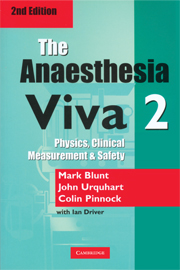Book contents
- Frontmatter
- Foreword to the First Edition
- Preface to the Second Editions
- Contents
- Physics, Clinical Measurement & Safety
- Clinical Anaesthesia
- Example 1
- Example 2
- 6 Example 3
- 7 Example 4
- Example 5
- Example 6
- Example 7
- Example 8
- Example 9
- Example 10
- Example 11
- Example 12
- Example 13
- Example 14
- Appendix 1
- Appendix 2
- Index
Example 7
Published online by Cambridge University Press: 05 February 2015
- Frontmatter
- Foreword to the First Edition
- Preface to the Second Editions
- Contents
- Physics, Clinical Measurement & Safety
- Clinical Anaesthesia
- Example 1
- Example 2
- 6 Example 3
- 7 Example 4
- Example 5
- Example 6
- Example 7
- Example 8
- Example 9
- Example 10
- Example 11
- Example 12
- Example 13
- Example 14
- Appendix 1
- Appendix 2
- Index
Summary
Scenario
A 60-year-old male patient with myotonia dystrophica appears on your list for cataract surgery. How would you conduct anaesthesia in a patient with the condition?
Myotonia dystrophica is an autosomal dominant condition affecting men and women equally, and is also known as myotonic dystrophy, dystrophia myotonica, myotonia atrophica, and Steinert's Disease.
Features
▪ Patient: this is a rare condition, inherited as an autosomal dominant with anticipation. There is wasting, frontal balding, diabetes, cataracts and mental retardation.
▪ Cardiovascular system: cardiac muscle is affected. Cardiac failure is the usual mode of death, in the sixth decade of life. Conduction defects are common.
▪ Respiratory system: pulmonary function is abnormal, and the CO2 response curve is right-shifted.
▪ Musculoskeletal system: myotonia results in delayed release of contraction, as in a handshake, and is precipitated by cold, exercise, shivering, hyperkalaemia, suxamethonium (intubation may be impossible) and neostigmine.
▪ There are no associations with the renal system.
Conduct of anaesthesia
▪ The surgery is often for cataract removal. This begs to be done under local anaesthesia. Other surgical procedures may be required, as for the general population.
▪ Preoperatively: 24 hour ECG may indicate rhythm instability. Lung function and ECG are mandatory. Avoid all sedative premedication.
▪ Anaesthesia: Regional techniques are relatively contraindicated because of the profound weakness produced (acceptable for eye surgery, however). Thiopentone causes profound depression, but propofol less so. Because of the likelihood of bulbar involvement, as well as respiratory muscle weakness, intubation and ventilation are essential. Suxamethonium is a disaster; atracurium, allowed to wear off at the end to avoid using neostigmine, is the preferred form of muscle relaxation.
[…]
- Type
- Chapter
- Information
- The Anaesthesia Viva , pp. 103 - 105Publisher: Cambridge University PressPrint publication year: 2003



